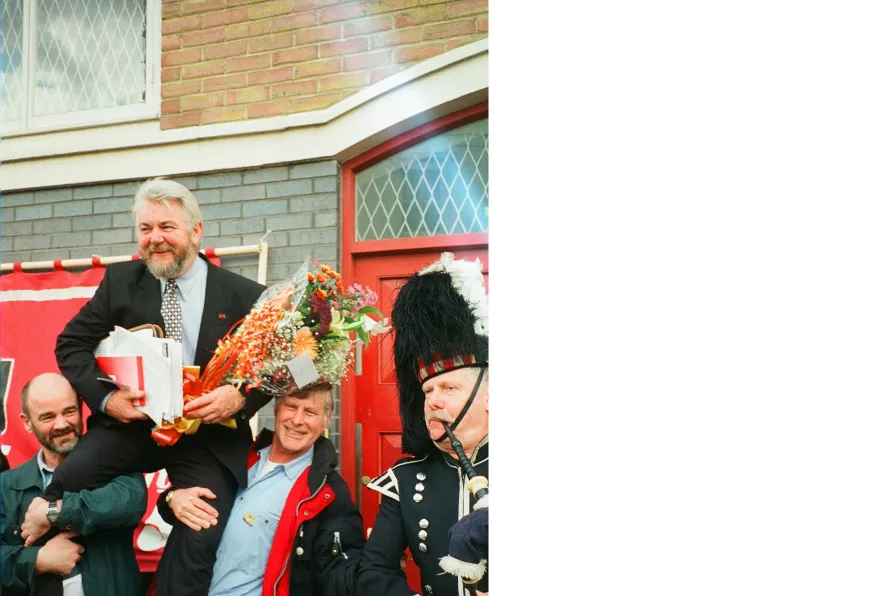What began as a regional alliance now courts Australia, Japan and South Korea while preparing three-front warfare — but this overreach accelerates Nato’s own crisis as member states surrender sovereignty to the US, argues SEVIM DAGDELEN

 John Haylett is carried back to the Morning Star in triumph – and piped in – after winning the strike
John Haylett is carried back to the Morning Star in triumph – and piped in – after winning the strike
JOHN HAYLETT was the catalyst that provoked a six-week journalist strike in 1998 threatening the future of the Morning Star, but ultimately saving it from a slow slide into extinction.
The first three years of Haylett’s editorship were marked by internal strife. He was appointed following Tony Chater’s retirement in 1995 and was a contentious appointment because it threatened a family takeover of the Star.
The People’s Press Printing Society’s chief executive Mary Rosser was married to Mike Hicks, the former general secretary of the Communist Party of Britain. Rosser’s son-in-law, Paul Corry, was deputy and news editor at the Star and the dynastic chief executive wanted him as editor.
The power struggle erupted in January 1998 when Haylett was suspended for gross misconduct.
The National Union of Journalists chapel did not take the emerging news kindly, but it was the breaches of the organisation’s own disciplinary procedure which truly ignited their anger.
The trumped-up charges were not put to Haylett so he could defend himself, nor were they dealt with under the house agreement covering disciplinary processes.
This in particular enraged NUJ members as they understandably felt that if the editor could be treated in this way then any member of staff was fair game.
Mother of chapel Amanda Kendal explained: ”It was a Saturday afternoon when John rang to tell me that he’d been suspended. He asked what I was going to do. The first thing, as it turned out, was to not get a wink of sleep that night!
“Over the coming days, it became clear that the Star’s then management had no interest in compromise or negotiation.
“They told the union they couldn’t show us the ‘dossier’ of allegations against John because they ‘didn’t know’ that the union represented him. On the Monday, it was because the ‘dossier’ was ‘the private property of the management committee.’
“The scene was set. None of us wanted to strike. Over the six weeks we were out we picketed in the mornings and, in the afternoons, worked to produce The Workers’ Morning Star.”
And the Star strike started with a bang with an eve-of-strike rally held at a packed Conway Hall in London on February 24, with support from labour movement luminaries like the Fire Brigades Union general secretary Ken Cameron offering support.
The dispute became national news with Channel 4 and BBC broadcasting interviews from the picket line. The coverage was not very sympathetic to the paper and played up the links to the Communist Party of Britain and the former Soviet Union, but it was coverage in the mainstream media and alerted people to the Star’s continued existence.
Channel 4 News was notable for the admission by Rosser that circulation had dwindled under her management to just 7,000. It includes an appearance on the picket line by Islington North MP, Jeremy Corbyn, who appears at about 36 seconds.
The BBC coverage also included a very strong interview with Tony Benn and showed a young Chris Kasrils working on the Workers’ Morning Star.
But the six-week strike was the best thing that happened to the Star. Striking journalists did rounds of meetings to talk to supporters and readers about the dispute and to discuss ways to improve the paper in the future.
Deputy father of chapel Chris Kasrils played a key role: “I first met John in the 1980s through the South African exile community in London, to which he was very close. It was an honour to later work alongside him at the Morning Star and an even greater honour to strike in his defence in 1998.
“The strike lasted six weeks, but under the command of our sacked editor the journalists launched their own weekly, The Workers’ Morning Star, which appeared for five issues until victory was secured with John’s reinstatement.
“Our cramped strike office, above shops on the Kingsland Road, became the centre of production. In those pre-internet days our journal was vital in keeping supporters informed about the dispute.
“The picket lines, mass meetings and other activities brought us, and the paper’s readers, much closer together and laid the basis for a new regime to replace the old Morning Star management after the strike’s successful conclusion.”
The pressure eventually led to Acas talks and a complete capitulation. So total was the surrender that Corry never appeared in the newsroom again and the management committee were replaced.
“We returned to work with John restored as editor after the management’s nominated representatives at Acas walked away, having at last actually seen the dismal nature of that infamous ‘dossier’,” Kendal explained.
“It was tough for everyone, but it was necessary — not only to (rightly) save John’s job, but with that, the integrity of the paper itself and, further, its future as a broad left publication,” she said.
The rebirth of the Star started with Haylett and the management committee able to appoint a new management team, including Kasrils, Kendal, Bill Benfield, Mike Ambrose, Alex Reid and Mike Parker to support the editor.
Where Rosser and her team had presided over a declining newspaper, the Star was redesigned with a modern look and the trade union movement actively engaged to support through adverts and sponsorship of special editions.


















